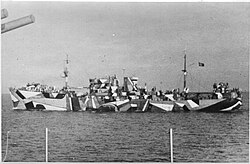Ulm (ship, 1937)
|
||||||||||||||||||||||
|
||||||||||||||||||||||
|
||||||||||||||||||||||
|
||||||||||||||||||||||
The Ulm was a former German reefer ship that was converted into a mine ship by the German Navy during World War II and used as such. The ship was sunk by British destroyers on August 25, 1942, southeast of Bear Island .
history
Freight service

The Ulm was built at the Danzig shipyard as a refrigerated ship named Rapide for the North German Lloyd . The 3,071 GRT ship was launched in November 1937, was put into service the following year and made several trips to Indonesia and Cameroon. The outbreak of war surprised the ship in Cameroon, but managed to overcome the British naval blockade and return to Hamburg.
Operation history as a mine ship
On March 18, 1940, the Navy took over the Ulm camouflaged as an Olsen liner and had it converted into a mine ship by Blohm & Voss . The stern received two inwardly opening flaps for dropping the mines, and the stern was prepared for receiving the mines. The first war operation took place in April 1940 east of the sea route between Dover and the Thames estuary .
On July 31, 1940, a fire broke out on the Ulm, as a result of which it had to undergo lengthy repairs at the Danish shipyard Helsingørs Jernskibs og Maskinbyggeri A / S in Helsingør . The Navy put the ship back into service on November 25, 1941 in Swinoujscie . The commander became the leader of the mining ships north, captain at sea Werner Schönermark . On November 27, she moved to Kiel, where she received her mine-laying equipment and armament from the German works . From January 6, 1942, the Ulm put several mine barriers in the Skagerrak , the western North Sea and in Norwegian waters. The Soviet submarine M-176 probably sank on one of these locks in the Varangerfjord .
Sinking
After the Ulm under Lieutenant of the Reserve Ernst Biet anchored on August 19, 1942 together with the destroyer Z 23 in Narvik in the bow bay near Narvik, she was supposed to mine the area northwest of Novaya Zemlya after the return of Admiral Scheer . On August 24, the Ulm sailed from Narvik to the “Zar” mining company in the Arctic Ocean together with the destroyers Friedrich Eckoldt , Erich Steinbrinck and Richard Beitzen . The instructions given by radio for the company could be deciphered by Bletchley Park , whereupon the Royal Navy put the destroyers HMS Marne , HMS Martin and HMS Onslaught on the Ulm . The destroyer arrived on August 25 about 150 nautical miles southeast of the Bear Island to the Ulm and took them under artillery fire. Two Onslaught torpedoes missed their target, but a third hit the fore. The Ulm exploded and sank within 150 seconds position 74 ° 45 '0 " N , 26 ° 50' 0" O . The commander, three other officers and 57 crew members were taken in by the British, but one of them died while on the voyage to Great Britain. Between 30 and 40 men were left floating in the water when the British abandoned their rescue work due to concerns about air attacks. Since there were a total of 181 men on board, 121 of the crew lost their lives, many of them from machine gun fire, when they gathered at the bridge to leave their ship.
literature
- Erich Gröner , Dieter Jung, Martin Maass: The German warships 1815-1945 . tape 3 : U-boats, auxiliary cruisers, mine ships, net layers, barrier breakers . Bernard & Graefe, Koblenz 1985, ISBN 3-7637-4802-4 , pp. 200 .
- Hans H. Hildebrand, Albert Röhr, Hans-Otto Steinmetz: The German warships. Biographies. A mirror of naval history from 1815 to the present day . tape 9 : Collective chapter landing craft, mine ships, minesweepers, speedboats, training ships, special ships, tenders and escort ships, torpedo boats, supply ships . Mundus Verlag, Ratingen, S. 39 (Licensed edition by Koehlers Verlagsgesellschaft, Hamburg, approx. 1990).
- Charles Hocking: Dictionary of Disasters at Sea during the Age of Steam 1824–1962. London 1984.
- Karl von Kutzleben, Wilhelm Schroeder, Jochen Brennecke: Mine ships 1939–1945. Koehler, Hamburg 2002, ISBN 3-7822-0844-7 .
- ADM 199/808; Public Records Office, London, Sinking of minelayer "Ulm"; "Most Secret" report dated August 30, 1942 by the Commanding Officer of HMS Onslaught; William Halford Selby.
- Supplement of the London Gazette of Friday, October 13, 1950: Convoys To North Russia, 1942, p. 5147 "sinking of ulm".
Web links
- German minelayer "ULM" on uboatarchive.net (English)
- Report on the sinking of the Ulm on wlb-stuttgart.de
- The Ulm on wrecksite.eu
Individual evidence
- ↑ E. Gröner among others: The German warships. Volume 3, 1985, p. 200.
- ↑ a b Ship 11 / Hanonia. Retrieved October 11, 2012 .
- ↑ a b c HH Hildebrand, A. Röhr, H.-O. Steinmetz: The German warships. Volume 9, p. 39.
- ^ Soviet submarine losses in the Arctic Ocean. Retrieved October 11, 2012 .
- ↑ HH Hildebrand, A. Röhr, H.-O. Steinmetz: The German warships . tape 3 : Ship biographies from the Elbe to Graudenz . Mundus Verlag, Ratingen, S. 152 (Licensed edition by Koehlers Verlagsgesellschaft, Hamburg, approx. 1990).
- ↑ Sea War 1942, August. Retrieved October 11, 2012 .
- ↑ German Minelayer "ULM" on uboatarchive.net ( Memento from July 3, 2012 in the Internet Archive ) (English)



